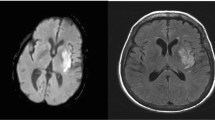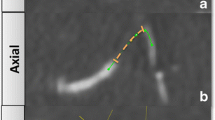Abstract
With the approval of intravenous recombinant tissue plasminogen activator (r-TPA) in 1995, acute ischemic stroke therapy is increasingly being administered. Currently the approach to imaging these patients is very simplistic. Typically, noncontrast head computed tomography (CT) is the only study performed prior to treatment. Advanced imaging using CT or magnetic resonance imaging (MRI) can play a very important role in the triage and classification of patients with acute ischemic stroke. With knowledge of the location and size of the occlusion as well as the collateral circulation, the best treatment can be selected, minimizing any morbidity from treatment and maximizing the chance of success. The identification and stratification of patients according to their imaging and clinical features will further individualize treatment and allow tailored therapy. This review will discuss rapid imaging techniques that are easily available and the rationale for their use.





Similar content being viewed by others
References
2001 Heart and Stroke Statistical Update (2002) American Stroke Association, Dallas, pp 1–8
del Zoppo GJ, et al (1992) Recombinant tissue plasminogen activator in acute thrombotic and embolic stroke. Ann Neurol 32:78–86
Jones TH, et al (1981) Thresholds of focal cerebral ischemia in awake monkeys. J Neurosurg 54:773–782
Zivin JA, et al (1985) Tissue plasminogen activator reduces neurological damage after cerebral embolism. Science 230:1289–1292
Tissue plasminogen activator for acute ischemic stroke. The National Institute of Neurological Disorders and Stroke rt-PA Stroke Study Group. N Engl J Med 1995 333:1581–1587
Albers GW, et al (2002) ATLANTIS trial: results for patients treated within 3 hours of stroke onset. Alteplase Thrombolysis for Acute Noninterventional Therapy in Ischemic Stroke. Stroke 33:493–495
Albers GW, et al (2000) Intravenous tissue-type plasminogen activator for treatment of acute stroke: the Standard Treatment with Alteplase to Reverse Stroke (STARS) study. JAMA 283:1145–1150
Clark WM, et al (1999) Recombinant tissue-type plasminogen activator (Alteplase) for ischemic stroke 3 to 5 hours after symptom onset. The ATLANTIS Study: a randomized controlled trial. Alteplase Thrombolysis for Acute Noninterventional Therapy in Ischemic Stroke. JAMA 282:2019–2026
Hacke W, et al (1998) Randomised double-blind placebo-controlled trial of thrombolytic therapy with intravenous alteplase in acute ischaemic stroke (ECASS II). Second European–Australasian Acute Stroke Study Investigators. Lancet 352:1245–1251
del Zoppo GJ, et al (1998) PROACT: a phase II randomized trial of recombinant pro-urokinase by direct arterial delivery in acute middle cerebral artery stroke. PROACT Investigators. Prolyse in Acute Cerebral Thromboembolism. Stroke 29:4–11
Furlan A, et al (1999) Intra-arterial prourokinase for acute ischemic stroke. The PROACT II study: a randomized controlled trial. Prolyse in Acute Cerebral Thromboembolism. JAMA 282:2003–2011
Katzan IL, et al (2000) Use of tissue-type plasminogen activator for acute ischemic stroke: the Cleveland area experience. JAMA 283:1151–1158
Chiu D, et al (1998) Intravenous tissue plasminogen activator for acute ischemic stroke: feasibility, safety, and efficacy in the first year of clinical practice. Stroke 29:18–22
Morgenstern LB, et al (2002) Improving delivery of acute stroke therapy: The TLL Temple Foundation Stroke Project. Stroke 33:160–166
Christou I, et al (2000) Timing of recanalization after tissue plasminogen activator therapy determined by transcranial Doppler correlates with clinical recovery from ischemic stroke. Stroke 31:1812–1816
von Kummer R, et al (1997) Acute stroke: usefulness of early CT findings before thrombolytic therapy. Radiology 205:327–333
Bryan RN, et al (1991) Diagnosis of acute cerebral infarction: comparison of CT and MR imaging. AJNR Am J Neuroradiol 12:611–620
Truwit CL, et al (1990) Loss of the insular ribbon: another early CT sign of acute middle cerebral artery infarction. Radiology 176:801-806
Tomura N, et al (1988) Early CT finding in cerebral infarction: obscuration of the lentiform nucleus. Radiology 168:463–467
Xavier AR, et al. (2003) Neuroimaging of stroke: a review. South Med J 96:367–379
Lev MH, et al (1999) Acute stroke: improved nonenhanced CT detection—benefits of soft-copy interpretation by using variable window width and center level settings. Radiology 213:150–155
Barber PA, et al (2001) Why are stroke patients excluded from TPA therapy? An analysis of patient eligibility. Neurology 56:1015–1020
Hamberg LM, et al (1996) Quantitative high-resolution measurement of cerebrovascular physiology with slip-ring CT. AJNR Am J Neuroradiol 17:639–650
Hunter GJ, et al (1998) Assessment of cerebral perfusion and arterial anatomy in hyperacute stroke with three-dimensional functional CT: early clinical results. AJNR Am J Neuroradiol 19:29–37
Ringleb PA, et al (2002) Thrombolytic therapy within 3 to 6 hours after onset of ischemic stroke: useful or harmful? Stroke 33:1437–1441
Kent DM, R Ruthazer and HP Selker (2003) Are some patients likely to benefit from recombinant tissue-type plasminogen activator for acute ischemic stroke even beyond 3 hours from symptom onset? Stroke 34:464–467
Lev MH, et al (2001) CT angiography in the rapid triage of patients with hyperacute stroke to intraarterial thrombolysis: accuracy in the detection of large vessel thrombus. J Comput Assist Tomogr 25:520–528
Christou I, et al (2002) Intravenous tissue plasminogen activator and flow improvement in acute ischemic stroke patients with internal carotid artery occlusion. J Neuroimaging 12:119–123
Libman RB, et al (1995) Conditions that mimic stroke in the emergency department. Implications for acute stroke trials. Arch Neurol 52:1119–1122
Author information
Authors and Affiliations
Corresponding author
Appendix
Appendix
CTA protocol (based on GE scanners)
Rights and permissions
About this article
Cite this article
Farkas, J., Xavier, A. & Prestigiacomo, C.J. Advanced imaging application for acute ischemic stroke. Emerg Radiol 11, 77–82 (2004). https://doi.org/10.1007/s10140-004-0347-2
Received:
Accepted:
Published:
Issue Date:
DOI: https://doi.org/10.1007/s10140-004-0347-2




